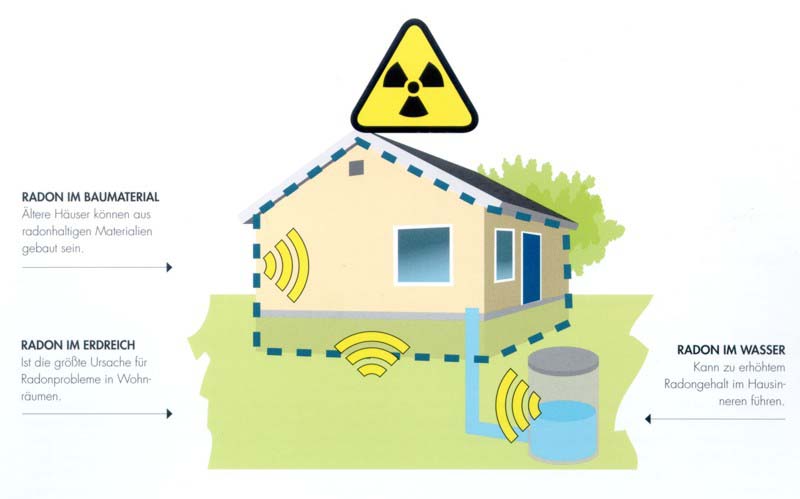RADON
Die 10 wichtigsten Fragen …
Binker Materialschutz GmbH
QUESTION 1: WHAT IS RADON?
Radon is a naturally occurring, radioactive, noble gas that is odorless and tasteless. It is formed from radioactive decay of Uranium and Radium. These elements are found ubiquitously in small amounts in most rocks, soil, and water. You can not see and smell Radon, but you may run into danger!
QUESTION 2: WHERE ARE RADON-AFFECTED AREAS?
Radon is found in small quantities in all soils and rocks, although the amount varies from place to place, depending on the geological underground. Radon from the ground is drawn through openings, cracks and gaps into buildings, like homes, offices, schools, kindergartens. Measurements in Europe, like in Germany, Austria and Italy, show Radon levels varying not only between different parts of the country but even between neighbouring buildings.
QUESTION 3: WHAT ARE THE HEALTH RISKS OF RADON?
Radon decays quickly, giving off tiny radioactive particles. When inhaled, these radioactive particles can damage the cells that line the lung. Long-term exposure to radon can lead to lung cancer, the only cancer proven to be associated with inhaling radon. The longer the Radon exposure and the higher the Radon concentration the bigger the risk of getting lung cancer. Exposure to the combination of radon gas and cigarette smoke creates a greater risk of lung cancer than exposure to either factor alone.
QUESTION 4: WHICH AREAS ARE AFFECTED BY RADON MOST?
The Radon concentrations in soil vary substantially from place to place depending on soil structure and composition or formation. Radon maps showing the geographical variations of the radon concentrations in soil allow only a rough estimation of the Radon risk in your home you may be faced with. However Radon is often measured in high krt tschechienconcentration even in non-affected areas.Therefore it is always absolutely necessary to survey and measure each home individually for Radon occurrence.
QUESTION 5: HOW DOES RADON ENTER YOUR HOME?
Air pressure inside your home is usually lower than the pressure in the soil around your home’s foundation. Because of this difference in pressure, your home acts like a vacuum, drawing Radon in through foundation cracks, crevices, holes, pipe lines, drain lines, pipe penetrations, joints and service openings. Radon may even seek through the foundation material itself if it is porous. Your home then traps the Radon inside, where it can build up. New wall insulations and therefore well-sealed homes may increase the Radon concentrations inside your home.
QUESTION 6: HOW CAN YOU DETECT THE RADON CONCENTRATION LEVEL IN YOUR HOME?
The only way to check your home for Radon is to carry out a Radon test, meaning measuring the Radon concentration in your home via test kits or monitoring devices. Our measuring systems are not expensive and easy to install. Knowing the radon concentrations in your home will help you to take the adequate action to protect yourself and your family from Radon. Feel free to contact us for assistance!
QUESTION 7: INTERPRETING THE MONITORING RESULTS: WHAT WILL THE RADON CONCENTRATIONS TELL YOU?
The lower the Radon concentrations in your home the lower your health risk. It is believed that any Radon exposure carries some risk. The best is to bring the Radon concentration level in your home down to the level in the outside air. The WHO recommends to take action if the average Radon concentration in your home exceeds 100 Bq/m3. The Becquerel (symbol Bq) is the SI-derived unit of radioactivity. One Bq is defined as the activity of a quantity of radioactive material in which one nucleus decays per second. The Bq unit is therefore equivalent to an inverse second, s−1.
QUESTION 8: HOW TO REDUCE THE INDOOR RADON CONCENTRATIONS IN YOUR HOME?
We offer reliable technical solutions to lower the indoor Radon concentrations in your home permanently. Those are: – Ventilations systems – Sealing techniques to caulk Radon channels – Barrier sheeting – Radon sump installations The best way to reduce the Radon levels in your home, office, facility or in dwellings, blocks and flats is our Corroventa® Radon sucker or extraction system. This easy to handle sub-slab soil ventilation system shows the following main features: approved and reliable, long-term stability, economic energy consumption, silent-running modus and easy to operate and to maintain: A real “peace of mind”-system! Lowering the Radon level in your homes means to protect your health and that of your family!
QUESTION 9: YOU WANT TO BUILT A NEW HOUSE. WHAT IS IMPORTANT FOR RADON PROTECTION?
If you plan building a new house, you should not forget Radon protection. We do offer many capabilities to keep your new house uninterruptedly Radon-free. These are Radon-barriers, drainages or heat recovery ventilation systems and first of all sub-slab soil suckers. The adequate method for your home is mainly governed by the construction technology, geological conditions, budget-capping and feasibility. Radon-protection can be carried out much easier during construction of your new house than after occupation. We recommend to you to call for our Know-how in Radon-provision already during the planning stage and construction phase. This will help you to get the best taylored Radon-prevention.
Please advise your architect to contact us sufficiently in advance!
QUESTION 10: WHAT SHOULD YOU DO NEXT?
Please give us a call for getting your home checked for Radon or get in touch with us to rent our easy to handle Radon-monitoring devices. Or just contact us for more informations and assistance:
Phone.: +49 (9123) 99820
E-Mail.: mail@radonprotection.eu
Web: www.radonprotection.eu











